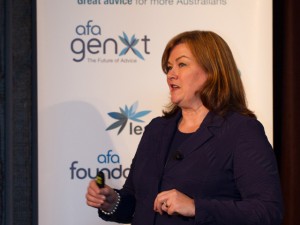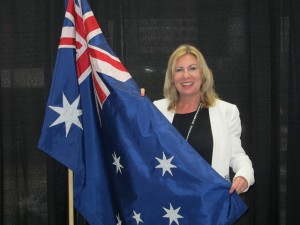A group of Australian advisers joined their peers from the United States, Canada and the United Kingdom to share their thoughts about some of the key issues impacting their businesses and their industry. The setting was the 2014 MDRT Annual Meeting, held in Toronto in June.
Our expert panel considered issues including: the extent to which clients and consumers understand life insurance; what can be done to improve the often misunderstood concept of insurance; new approaches to addressing the underinsurance dilemma; whether risk-focused advisers could ever operate a successful fee-based advice practice; and other issues relevant to the future of life insurance advice in Australia and around the world…

The panel (L to R):
- Peter Pearson (Canadian adviser)
- Michelle Hoskin – Standards International (United Kingdom best practice industry consultant)
- Ashley Pattinson (Australian adviser)
- Susan Paterson – Adviser and MDRT Australian Chair
- Kristine Brooks – Zurich Financial Services Australia – Sponsor/supporter and institutional contributor to discussion
- Jenny Brown (Australian adviser)
- Brian Ashe (former MDRT President and United States adviser) – inset
‘Mis-insurance’
Our panel kicked off by comparing notes about whether they believe their clients and consumers have an appropriate understanding of life insurance – what it is and what it means…
Canadian adviser, Peter Pearson, suggested consumers who already have life insurance generally have little more than a basic knowledge. “They might know they have some cover: ‘Yes, I have some insurance through work,’ and they think that is usually sufficient. But after they have gone through the advice process with us – fact finding and discovery – they almost always appreciate they have inadequate cover for their needs,” said Peter.
“Even though Canada is one of the most insured countries in the world, there is only a very general understanding about life insurance – by those who have it, and those who don’t – without a specific appreciation of what it is and what it does. Doctors may know a bit about disability insurance but few other occupations or consumers do,” he said.
Australian adviser and 2013 AFA Adviser of the Year, Jenny Brown, said her clients have a general idea about life insurance “… and we constantly remind them what cover they’ve got and why they’ve got it. But when new clients visit, they realise how little cover they have.” Jenny told her peers it was very rare to have an initial meeting with a client who already has appropriate insurance cover in place. “Most don’t, even though many of them believe they do,” she said. “They just don’t think about the ramifications of how events can affect them.
“We try to educate our clients through articles and newsletters and a series of educational videos. And it’s also important that we continually educate the wider market – not just our clients, but everybody. The more we can educate, hopefully the more we can increase the general level of insurance across the community.”
Incoming MDRT Australian Chair and Queensland-based adviser, Susan Paterson, emphasised that the review letters her practice sends to existing clients highlight not just the life insurance products their clients have, but the ones they don’t. “We’ll try to get on the phone to our clients at review time as well, and one of the conversations I will have is ‘Ok, you’ve got life and trauma insurance, but you don’t have total and permanent disability insurance. As your adviser we need to understand why you don’t have this cover. So you must have thought about this – what was your thinking, so that I’m on the same page as you.’ It’s difficult for the client to then provide an explanation as to why there is this gap in their cover.
the language we use as advisers is so heavily tainted by our compliance regimes
 “But I agree very much that there is this sense that consumers in general think they have enough insurance because they say they have cover via their super fund at work and believe they don’t need anything further,” said Paterson.
“But I agree very much that there is this sense that consumers in general think they have enough insurance because they say they have cover via their super fund at work and believe they don’t need anything further,” said Paterson.
NSW corporate superannuation specialist adviser, Ashley Pattinson, agrees with the sentiment that un-advised policy holders generally believe they already have enough life insurance: “Do people understand what life insurance they’ve got? In my experience the answer is typically ‘no’, especially for that cover provided through a superannuation plan. There have been a lot of conversations in the media about default levels of insurance, but the problem is that most default levels are inadequate for most people and there is also an attitude that, ‘I have insurance in my super, so I can now tick that box’; people think that they are appropriately covered when they are not,” said Pattinson.
Compliance and mis-insurance
“But what are they really covered for?” continued Pattinson. “I think part of the issue for us is that the language we use as advisers is so heavily tainted by our compliance regimes to the point that we forget to talk about what it is that the insurances will actually do. So, it’s important to talk about what it does, not what its name is. As advisers, we’ve been so side-tracked with making sure that what we do and write is compliant that we’ve forgotten how to talk to people about what it is that we actually deliver.”
To illustrate his point, Pattinson outlined the difficulty associated with providing an initial ‘high-level’ solution for the client: “You can’t just have a preliminary conversation with somebody and sketch out a strategy. To get to that point you first have to issue a 30 or 40-page Statement of Advice (SoA) and say, ‘This is what we talked about and this is what it’s going to cost’. We can’t get to the point of saying ‘this is how much it’s going to cost’ without having to make a product recommendation. And that’s just ludicrous. I can’t think of another industry where you have to go all the way down the decision-making process as if you had actually purchased the item before you can find out how much it’s going to cost you. Why is it that we do that? Can’t we just say to our clients that if you think this is a good idea, I can do some rough numbers and give you an indication of what it will cost? I’m not going to give you a product recommendation at this point in time. We’re going to set the scope of what it’s going to cost and how we can structure it and then we can sit down together and work out how we’re going to proceed. And at that point in time, once we have agreed, I can then select which products will be most appropriate.”
The panel agreed it is often difficult – too difficult – to deliver simple advice because of the nature of compliance and regulation.
Jenny Brown: “I think the conversation needs to start around, ‘This is a ballpark figure and this is what you can get for it.’ And once you receive an indication from the client that you’re working within the right parameters, if you can just do that, then we can get into more detailed analysis and budgeting and we can go to the next level. At the moment compliance and regulations prevent us from doing that.”
Reinforcing the point further, Pattinson added: “To get a price at the moment, you have to select a product. And the moment you select a product to get the price, you’ve made a recommendation – and you can’t make a recommendation unless you’ve done an SoA!”
Providing evidence that this type of frustration with compliance is not isolated to Australian conditions, UK best practice consultant, Michelle Hoskin, told the panel of her recent experience in completing her own family’s life insurance plan. “I asked the adviser to treat me just like a normal client so I could have that experience. The whole life insurance, critical illness, disability issue was quite confusing. We had tables and documents and it got to the point where I said: ‘Just tell me which product I need.’ It was confusing and all I ended up with was a spreadsheet with different premiums, terms and options on it.
“But, the adviser was very good at helping us articulate why we wanted insurance. He didn’t focus on how much we wanted to pay. He did ask what we could afford, but that was a very small portion of the conversation. So, in terms of confidence in my adviser, when he came back with his recommendations we were quite comfortable.
“Even though I work in the financial services industry, as a recipient of that process it was confusing. But on the other side of that, my adviser really made me think about why it was important and talked very little about how it would happen or what it would look like when we got it. He was really good about helping us appreciate why we needed the insurance.”
Peter Pearson told the panel that Canadian regulations require no such advice compliance when purchasing life insurance. In terms of being able to provide a ‘rough sketch’ of a client scenario, Pearson said: “You can do it with a yellow pad and ‘the gift of the gab’ or you can do a full-blown needs analysis.” He added that the only Canadian province which requires a formal plan to be presented to the client for life insurance is Quebec.
But Pearson added that Canada is looking at compliance models now operating in Australia and the UK. “I don’t think there’s anything wrong with what they’re doing – it’s all in the hope that they’re going to make the consumer aware of what’s going on. It’s all about the regulators wanting the client to know what they’re paying for.”
until we can reach a point where people genuinely understand what insurance they have, and why they have it, then we will always continue to have misinsurance
Zurich Financial Services Australia’s Kristine Brooks shared with the panel that their comments about clients not understanding insurance, and the challenges associated with delivering advice, validated her company’s concerns and was one of the reasons why Zurich had undertaken a recent consumer research project focusing on general perceptions and understanding of life cover and other types of insurance.
“We surveyed Australian consumers initially about their insurance literacy and we also found that, even with the people that had engaged with life insurance, they didn’t really understand what they were covered for,” she said. “We labelled this phenomenon ‘mis-insurance’, which we believe is as problematic as the more widely discussed underinsurance issue. And until we can reach a point where people genuinely understand what insurance they have, and why they have it, then we will always continue to have mis-insurance.”
Kristine added, “It’s really concerning that even for the people that do have insurance, they have generally not gone through a needs analysis to determine whether they have the right insurance.
“The most alarming statistic from our research was that 5% of the people we surveyed believed they were covered for optical and dental expenses in their super fund! People don’t seem to distinguish between health insurance and life and income protection insurance.
“My overarching comment would be that we already know about the level of underinsurance, but then the people that have taken that step of taking out cover don’t understand what they’ve got and the industry has quite a significant task ahead of it to rectify that.”
Ashley Pattinson agreed: “I tend to see a lot of ‘entitlement’ attitude when I talk to super fund members, along the lines that they expect someone else is taking care of their insurance needs. A typical consumer attitude says ‘the Government will look after me’, or ‘my employer will give me sick pay’, or ‘someone else will take care of me even though I should take care of myself’.”
Brooks concurred, suggesting typical consumer attitudes picked up from the Zurich survey included similar approaches, such as: ‘The fact that I have insurance in my super fund means my employer must know what I need. So, surely I’m ok’.”
“And maybe that’s the positioning we have around superannuation in Australia,” continued Brooks, “… that it’s there to look after me in retirement, so maybe people don’t take the personal ownership of what their insurance needs really are.”
Susan Paterson suggests the industry needs to work on the ‘communication piece’. “One of the letters for my client from their insurer, that I also received, was too confusing. Even I didn’t understand what they were saying because it was so poorly-worded. How is a client going to understand what you’re saying about their insurance? So, to a point, the issue is one of communication.”
Former MDRT President and US adviser, Brian Ashe, told the panel that in the United States, which is considered to be a very mature market place, 40% of adults in the country have zero life insurance and the ownership of life insurance is at a 50-year low. “And that is within an environment that has seen a significant reduction in premiums, and where wages have increased,” he added.
“The industry sells seven million less policies per year than it did 15 – 20 years ago. So we have been asking ‘What is the disconnect here?’ I think a lot of it has to do with consumer education (or an implied lack of it). If you ask people in the US about what they think about buying life insurance, the research shows they generally overestimate the cost of insurance by around 300%. So obviously the message is not getting through that life insurance is a very affordable product.”
 Ashe told the panel he is also witnessing more of a ‘sea change’ in the perception of need – because people have to buy into the need before they buy the product. “It’s my belief that we concentrate too much on probabilities as opposed to the consequences.” Ashe invoked the confronting analogy from the Academy Award-winning film ‘The Deer Hunter’ to drive home his point: “In The Deer Hunter, Christopher Walken’s character is playing Russian Roulette – putting a six shooter to his head. I asked an audience at an event where I was speaking recently, what were the chances of his character putting a bullet through his head? One in six, yes. He has an 83% chance of being successful and only a 17% chance of failure. If we look at investments or retirement, I’d take that bet because 83% of the time I’m going to be right.
Ashe told the panel he is also witnessing more of a ‘sea change’ in the perception of need – because people have to buy into the need before they buy the product. “It’s my belief that we concentrate too much on probabilities as opposed to the consequences.” Ashe invoked the confronting analogy from the Academy Award-winning film ‘The Deer Hunter’ to drive home his point: “In The Deer Hunter, Christopher Walken’s character is playing Russian Roulette – putting a six shooter to his head. I asked an audience at an event where I was speaking recently, what were the chances of his character putting a bullet through his head? One in six, yes. He has an 83% chance of being successful and only a 17% chance of failure. If we look at investments or retirement, I’d take that bet because 83% of the time I’m going to be right.
“The consumer is thinking in probabilities as opposed to consequences,” said Ashe. “Would you pull the trigger? Most people wouldn’t, because the consequences are catastrophic. But when it comes to their planning, they don’t think of catastrophic consequences; they’re going on the percentages. We can’t extrapolate down to any one individual what those probabilities are. So, to me, if there was a paradigm shift in talking about the consequences versus the probabilities of something happening, people might pay a little more attention.”
Hoskin agreed: “And maybe that’s why my own life insurance adviser was so successful with me – because he really didn’t talk about probabilities at all. It was more about what you want and why.”
Susan Paterson recalled the death of Steve Irwin: “All of a sudden people wanted to get life insurance.”
Ashe: “Yes – that’s because they saw first-hand the consequences.”
The panel agreed that Brian’s point about consumers focusing on the probabilities rather than the consequences was an issue common to the global insurance sector. Further reinforcing this point, both Michelle and Susan cited their own parents’ approach as examples of Brian’s point about most people just looking at the probabilities as opposed to the consequences.
maybe people don’t take the personal ownership of what their insurance needs really are
Brian continued, “You could also consider ‘Chance’ versus ‘Choice’,” pointing out that people like to be in control of their lives. “If I do something that gives me choice, I’m in control. But if it’s left to chance, and it’s perceived as being chance, then I think that maybe people would be a little more sanguine about their approach to life insurance.”
Insurance education
The panel’s discussion about consumer attitudes towards life insurance flowed into the issue of consumer education.
Kristine: “In Australia I don’t think we’re great at educating the public about the benefits of ‘claim’. You just don’t hear enough in the media about the positive impact that claims make in peoples’ lives.
“As an insurance company employee, I hear amazing stories about the impact that claim benefits make, at the worst possible time in people’s lives. If you only hear one of those stories it would be enough to change your perception of insurance.”
The reason that the life insurance message is not resonating with the American public today, as much as it did in the past, according to Ashe, is partly because of a lack of education. “In the US in 1994, a group called the Life and Health Insurance Foundation for Education – ‘LIFE’, was formed. Because there had been some company failures and interests rates came down and products weren’t performing as well as they had, the industry was getting a ‘black eye’, so we wanted to turn it around. LIFE was formed because there was no organisation that existed that said good things about the products, the companies, the advisers and why you should be considering buying life insurance.”
Ashe emphasised the importance of consumer education and constant delivery of the message, citing the marketing efforts of Coca Cola: “Coca Cola is probably the best-selling brand in the world, but do they ever stop advertising? They keep on reinforcing the message. As an industry, I don’t think we reinforce the message. The companies may count on the advisers to do it but the advisers need the material and there has to be some ‘overlay’ for reaching the larger mass audience, at least to prepare the way – to ‘soften the beaches’ – for the type of messages that we would like to deliver. And that overlay has been largely absent, not only in the United States but probably across the world.”
Brian believes it is the industry’s responsibility to send this overlay message, not governments’, even though the industry helps governments by reducing consumers’ need for government assistance.
“In this country we have lots of insurance companies who are very competitive and it is difficult to find common ground: ‘Why should I do something for the industry when it will help my competitors?’ But the message of the LIFE Foundation is that a rising tide lifts all boats, which creates a much better atmosphere for the sale of life insurance products.”
The panel agreed that if the industry educates, including telling its claims stories, then it’s effectively helping to make sales via the back end of the conversation. Kristine: “I can tell you that what I have to offer is really good, but if someone else tells you I’m really good, then that will resonate more with the target of the message.”
Ashe also outlined two different campaigns undertaken by LIFE: Real Life Stories, which shows the benefits of what happens with insurance claims and how this made a difference, and Life Lessons, designed for young people who experience difficulties because their parents do not have insurance. “So, Real Life Stories shows what planning did to help solve problems and Life Lessons shows the problems young people had when there was nothing in place.”
Underinsurance
The panel agreed there is a global underinsurance dilemma and also agreed the long-term solution lies in education.
But Michelle added: “It’s education, but it’s also a cultural issue. We live in a world of instant gratification – a disposable world now, where everything is tangible and we’re becoming quite materialistic. We could educate until the cows come home, but the way that society is becoming more ‘hard-wired’ is that we want stuff that we can touch and feel and play with. And we want it now.” She said consumers will be saying to themselves, ‘I’m never going to benefit from my life insurance…’
Ashley: “When you start talking about education there’s a danger that you start talking about product names and meanings – that is, what does the term ‘total and permanent disablement mean? It’s not the name of the product that needs to be ‘educated’. It’s the outcome we’re looking for – what’s the outcome if you have the cover? I couldn’t agree more that awareness and education is paramount.”
Within the US, Brian said the LIFE Foundation (now known as Life Happens) has nominated September every year as ‘Life Insurance Awareness Month’. “We now have about 125 companies and associations who join in support of that, who have been able to secure endorsements through the Governors of about 50 states, talking about the importance of the product. This has evolved over 20 years and it’s an opportunity for the industry to come together. They can do some personal branding of the material but you need that type of an effort.”
Because of the digital nature of the mass campaigns during Life Insurance Awareness Month, Brian told the panel the campaign has been able to deliver measurable success, including reports from some large insurance firms that they experienced 20% – 30% spikes in the purchase of insurance. “So it’s an indication that when people concentrate on it – when they get the message out, when they encourage their people to work with the message – it is deliverable and it does generate results.”
Will payment of life insurance commissions be banned one day?
With the reinforcement of feedback given by her peers at a recent MDRT event, Susan said no adviser appears ever to have had a client question commissions. In fact, Susan told the panel that clients in all countries have an expectation that commission is built into the life insurance advice solution. “As long as the client understands how the payment is formed, how it arrives, no-one has had any issues.
The consumer is thinking in probabilities as opposed to consequences
“So if the notion of banning all life insurance commissions does get pushed, it will be a political agenda, and not come from consumers,” she said.
Jenny Brown told the panel she has spoken to lots of advisers who have tried charging fees for life insurance advice without success. “Those that have worked through it have said it just doesn’t work… because you can’t charge appropriately for your time. Clients won’t pay it. If I actually charged my clients what it costs to put a life insurance policy on the books I don’t believe they would pay it and they have told me they wouldn’t.
“If someone comes through and they’re a ‘cleanskin’ and they get accepted and put on the books in two days, that’s great – we’ve made money. But what about all the cases where it has taken weeks? And what happens if, ultimately, the client’s application is declined? How do I turn around to you as a client and say, ‘Ok, we’ve done all this work, we’ve actually got ten thousand dollars-worth of fees on the books and you’re not covered. Are you going to pay me?’
“So the clean skin going through quickly (and those are very rare) will compensate for the other times – the time it takes for other clients – and it’s just a fact of life. I don’t believe it will change and I agree the only way it’s going to turn around is because it will be legislated, not because consumers are pushing it.”
Michelle: “If you’re an advice firm that only provides insurance advice, then commissions is the only way. But when the insurance process is packaged with other financial planning advice, such as cash flow modelling, wills, trusts etc, I don’t think clients have a problem paying the fees for the value of advice. But for life insurance totally on its own – you can buy it from a supermarket.”
Jenny: “We’re a full service advice practice and it still doesn’t work. Speaking with a Queensland adviser who trialled it as part of an accounting practice, she said charging fees for life insurance advice doesn’t work, because the cost to service is too high. Even when it’s packaged in with other advice, it still doesn’t work.”
Susan agreed with her colleagues about cleanskin cases subsiding the more difficult underwriting cases: “It’s almost a ‘socialist’ approach, where commissions received for the less difficult insurance applications subsidise the costs associated with the more difficult cases. If we change that then the underinsurance issue would be even worse.”
Kristine noted that a good outcome of financial services reform in Australia, part of which has included the banning of investment and superannuation commissions, is that most advisers now know how much their services actually cost, where previously they did not know.
Ashley told his peers it costs his firm $2,300 to produce a risk SoA: “… and that’s just for the delivery of the advice; not the implementation of the advice, which comes at an additional cost.”
Ashley added that, in a utopian environment where the consumer understood the value of advice and the need for appropriate insurance cover, then paying a fee for life insurance advice could be palatable to people. “But in the current environment, where regulatory over-reach has pushed up the cost to deliver advice, even if the client thought it was appropriate to pay for advice, the cost of us delivering that advice is beyond what most consumers are prepared to pay.”
Brian commented that, from the regulator’s perspective, fees are perceived as ‘pristine’ and commissions are not. “But the reality is that no-one has ever been able to legislate morality,” he said, pointing out that one of the largest financial crimes in US history, that of Bernie Madoff, was entirely based around fees rather than commissions.
Ashe said people like choice: “So why not have two systems that people can compare – you can pay a fee or you can pay by commission.”
Reducing/Standardising life insurance commissions
In response to the notion that perhaps commissions should be standardised in order to remove conflict of interest, Jenny said she believes the level of upfront commissions in Australia is too high, and if the entire industry moved to either a hybrid or level commission system it would be a lot more palatable to the regulator.
The panel agreed that, for the whole industry to move on commissions, it would need cooperation between all the companies. They agreed it would be easier for mature businesses if the level of upfront commissions was reduced, but for new advisers it would be very difficult. Peter Pearson suggested there may need to be a policy of bridging finance implemented to assist the newer practices until they had built their portfolio of clients.
Pearson added that only one insurance company in Canada offers the equivalent of level commissions. “That is the company I work with, and have done so for over 20 years. So I have never received ‘heaped’ commissions from day one. It certainly pays dividends now,” said Pearson, referring to the level of his businesses’ annual recurring commission revenue.
Peter continued that most Canadian brokers probably would not be keen to sell hybrid or level commissions unless they had some bridging support or volume bonus structure. “But that is then something that can lead to conflict of interest,” he warned. However, Pearson also emphasised that Canadian studies have established there is no relationship between advice delivered and commission received. That is, adviser remuneration by commission does not, according to the Canadian research, generate any actual conflict of interest.
a rising tide lifts all boats
Peter and Brian agreed that on the topic of politicians and/or regulators considering the future banning of life insurance commissions “… it’s almost like there’s a witch hunt, where there’s no witch.”
On charging fees for life insurance, Brian also observed: “If it was only fees, what is the natural tendency in business? Reduce the fee. Then there’s a race to the bottom. And then the adviser can’t be appropriately compensated; the client is now receiving no service, the organisation is getting no income and things begin to crumble.”
Kristine offered a different perspective on this topic: “We don’t need to educate the consumer about our fees and how we are paid – we need to educate the regulator!”
Kristine related a recent tip from Australia’s Assistant Treasurer, Senator Mathias Cormann, when he said, “You need to stop articulating the benefit you will receive as the adviser [how I’m going to get paid] and you need to begin articulating the benefit you will receive as the consumer.” The example used by the Senator was the benefit to the consumer in paying commissions is that it makes life insurance advice accessible to those who couldn’t afford an out of pocket advice fee.
“Our own research shows that if we were to go to a mandatory fee-based model many consumers would not be able to afford life insurance advice and would abandon the market all together,” said Brooks.
Michelle told the group that regulation in the UK has converted sales people into business owners. Those advisers that are struggling the most, according to Michelle, are addressing their businesses as a lifestyle business rather than as a commercial business. “So those that are addressing the world as a business have no problem in charging their clients fees for insurance, even when they don’t have to,” she said.
Hoskin also stressed that, because of the way UK advisers are now describing their fees, clients are developing a greater appreciation of the value advisers deliver, and the importance of that advice. She said clients also see the advice proposition more clearly as a commercial transaction between the business and the consumer. “So it’s being approached differently and the delivery of the fee conversation is half the battle,” she concluded.
Where to from here?
In bringing together the threads from a wide-ranging set of conversations between a diverse, international group of advisers and industry experts, there were several key messages:
- Consumers have a very low understanding, or misunderstanding, of the nature of life insurance, whether or not they have cover, and mostly fail to appreciate its value
- Advisers and consumers should have the opportunity to determine the nature of the adviser’s remuneration for the life insurance advice they deliver
- In a real world, it is virtually impossible for risk-focused advisers to charge a fee for their advice and remain in business
- Mass consumer education will remain a vital and critical component in the quest to address what is a global underinsurance issue
- The solution to underinsurance and mis-insurance rests in the hands of the life insurance industry; not with governments
















